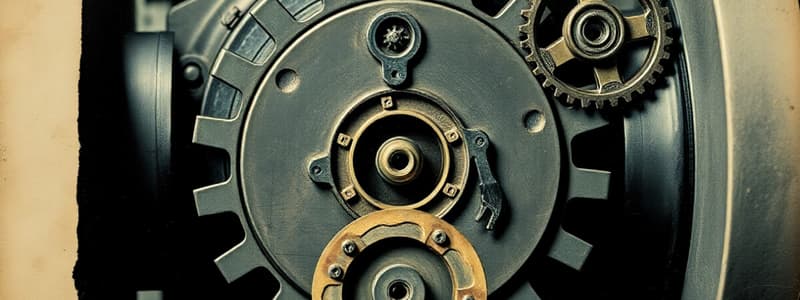Podcast
Questions and Answers
Which component is primarily used to connect rotating elements in a mechanical system?
Which component is primarily used to connect rotating elements in a mechanical system?
- Brake
- Clutch (correct)
- Gear
- Spring
What type of coupling allows for some misalignment between connected shafts?
What type of coupling allows for some misalignment between connected shafts?
- Solid coupling
- Flexible coupling (correct)
- Rigid coupling
- Direct coupling
Which of the following is primarily used to dissociate motion in a mechanical system?
Which of the following is primarily used to dissociate motion in a mechanical system?
- Clutch
- Gear
- Brake (correct)
- Spring
What is the main purpose of a spring in mechanical design?
What is the main purpose of a spring in mechanical design?
Which type of gear is designed to transmit motion at a non-parallel axis?
Which type of gear is designed to transmit motion at a non-parallel axis?
Flashcards
What are keys?
What are keys?
Keys are mechanical fasteners used to connect rotating shafts to other machine components.
What are couplings?
What are couplings?
Couplings connect shafts to allow for misalignment and flexibility.
What are clutches?
What are clutches?
Clutches are mechanical devices that engage or disengage power transmission.
What are brakes?
What are brakes?
Signup and view all the flashcards
What are springs?
What are springs?
Signup and view all the flashcards
Study Notes
Keys and Couplings
- Keys are used to transmit torque between a shaft and a rotating component.
- Types of keys include:
- Sunk keys
- Woodruff keys
- Feather keys
- Keyways are the grooves cut into the shaft and the component to accommodate the key.
- Key selection depends on torque, shaft diameter, and material strength.
- Couplings connect rotating shafts, accommodating misalignment and providing a flexible joint.
- Types of couplings include:
- Rigid couplings
- Flexible couplings (e.g., flange couplings, muff couplings, Oldham couplings)
- Coupling selection depends on the required torque transmission, misalignment, and overall system requirements.
Clutches
- Clutches are used to connect and disconnect rotating shafts smoothly.
- Types of clutches include:
- Friction clutches (e.g., single plate, multiple plate, cone clutches)
- Positive clutches (e.g., dog clutches)
- Clutch selection depends on the application's requirements, such as torque transmission capacity, engagement speed, and smoothness.
- Design considerations for friction clutches include friction surface material, pressure, and lubrication.
- Clutch engagement and disengagement mechanisms vary according to the type.
Brakes
-
Brakes are used to control or stop the rotation of a shaft.
-
Types of brakes include:
- Mechanical brakes (e.g., band brakes, block brakes, shoe brakes)
- Hydraulic brakes
- Electromagnetic brakes
-
Design factors for brakes include the force required to stop rotation, friction material selection, heat dissipation, and safety.
Springs
- Springs are mechanical components that store energy by deforming and release it when the load is removed.
- Types of springs include:
- Torsion springs
- Compression springs
- Extension springs
- Leaf springs
- Spring selection criteria include spring rate, stiffness, material, and fatigue life.
- Stress analysis and design are crucial for spring selection and durability.
Gears
- Gears transmit power and motion between shafts.
- Types of gears include:
- Spur gears
- Helical gears
- Bevel gears
- Worm gears
- Gear design parameters include gear tooth profile, module, pressure angle, and face width.
- Gear materials vary depending on application.
- Gear efficiency and noise are significant considerations for design
Objective Questions (Sample - 30 Questions)
- What is the primary function of a key in a machine?
- How do different types of keys differ in their design and application?
- Describe the principle behind the operation of a friction clutch.
- List three types of couplings and their advantages.
- What are the key design considerations for selecting a spring?
- Differentiate between spur gears and helical gears.
- Why is heat dissipation a critical factor in brake design?
- Explain the advantages of using different types of clutches in a mechanical system.
- Indicate the critical criteria in selecting gears.
- Describe the function of a torsion spring.
- Explain the difference between a compression and an extension spring.
- How are keys selected for shafts of varying sizes and loads?
- What are the crucial factors impacting the selection of a coupling?
- What are the key characteristics of a good clutch material?
- Explain the concept of spring rate and its significance in design.
- What are the primary functions of a brake in a machine?
- How do mechanical brakes differ from hydraulic brakes?
- Compare and contrast the applications of different gear types.
- Discuss the material selection process for different types of springs.
- What are typical failure modes for clutches, brakes, gears, and couplings?
- Discuss the concept of gear train and its applications.
- How does the load affect the selection of springs?
- Explain the concept of backlash in gears.
- Describe how the design of a coupling affects the overall system reliability.
- What are the essential factors to be considered during clutch selection?
- How does the type of lubricant impact the efficiency of mechanical brakes and clutches?
- Explain the concept of bending stress in gears.
- List the differences between rigid and flexible couplings.
Studying That Suits You
Use AI to generate personalized quizzes and flashcards to suit your learning preferences.




